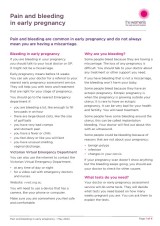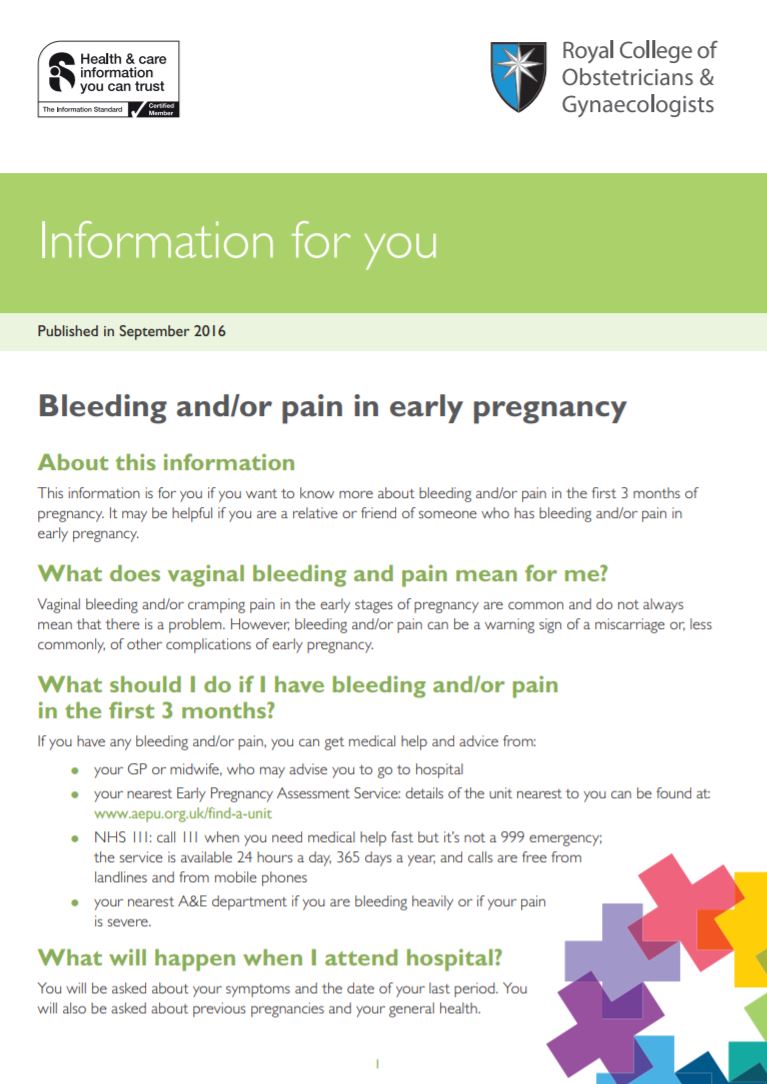Pain and bleeding in early pregnancy | Totonga hapūtanga
Key points about pain and bleeding in early pregnancy
- It is common to have pain and/or bleeding in early pregnancy (totonga hapūtanga).
- Most people who experience it go on to have a healthy pregnancy and baby.
- However, it can be a warning sign of a miscarriage or an ectopic pregnancy, so you should talk to your lead maternity carer (LMC) or doctor if it happens to you.

- Any pain (kōharihari) in the lower part of your tummy and/or bleeding (toto) from your vagina (tenetene) in the first 3 months of pregnancy should be checked out.
- Pain and bleeding in early pregnancy affect about 1 in 4 pregnant people, but most go on to have a healthy pregnancy and baby.
- Common causes include implantation bleeding, cervical bleeding, miscarriage and ectopic pregnancy.
- You may need to have blood tests and an ultrasound scan to find out the cause. Sometimes a cause cannot be found.
- If you feel upset or distressed about this happening, there is support available.
|
Contact your midwife or GP, or go to the nearest emergency department if you have any of the following symptoms: |
|
Causes
Possible causes of pain and/or bleeding in early pregnancy include the following:
- Implantation bleed – this usually happens around the time your period would have been due. It happens when the developing embryo attaches itself to the wall of your womb. The bleeding is usually light and there is no pain.
- Cervical bleed – your cervix is prone to bleeding in pregnancy due to hormonal changes and increased blood flow to your cervix. This can also happen after sex. This bleeding is usually harmless but if you have had an abnormal cervical screening result or are overdue for cervical screening, your cervix must be checked by a doctor to make sure that there is no abnormality on your cervix.
- Miscarriage – this is the loss of the pregnancy before 20 weeks’ gestation. Read more about miscarriage.
- Ectopic pregnancy – this is a pregnancy that occurs outside of your womb. Read more about ectopic pregnancy.
Other causes of pain and/or bleeding not related to pregnancy include:
- vaginal/cervical injury
- polyps or cervical abnormality
- an infection of your womb or cervix
- other causes of abdominal pain, such as a urinary tract infection (UTI), appendicitis or constipation.
You should see a doctor or midwife if you have bleeding in early pregnancy. How urgently you need to be seen depends on how much bleeding you have.
Spotting
A few spots of blood on your underwear or toilet paper is known as spotting. With spotting, a panty-liner is enough and you don’t usually need a pad. If you have spotting in early pregnancy, contact or make an appointment with your midwife or GP. It is okay to wait 24–48 hours for this appointment.
Moderate vaginal bleeding
If you soak your pad with 2–4 hours, or you have pain that doesn’t improve with pain relief, you need to contact or see your midwife or GP more urgently, usually on the same day.
Heavy vaginal bleeding
If you have heavy vaginal bleeding, you need to seek urgent medical help. This occurs when you soak your pad in less than an hour or you pass large clots and tissue. Contact your midwife or GP, or go to the after-hours doctors or nearest emergency department.
Your midwife or doctor will ask you some questions about your symptoms, including when they started, the date of your last period and about your past pregnancies. Your doctor may also examine your tummy and vagina to work out what is causing your bleeding and/or pain. A vaginal examination will not harm the pregnancy or cause you to miscarry.
You may need some blood tests and an ultrasound scan, depending on what your doctor or midwife thinks is causing your symptoms. The ultrasound scan can be done either abdominally (when the ultrasound probe is on the lower part of your tummy), or vaginally (when the ultrasound probe is inserted into your vagina). In early pregnancy, often a vaginal scan needs to be done in order to get a clear view of your womb. You may also need a urine pregnancy test to confirm your pregnancy if this has not already been done.
Sometimes, it may not be possible to find out the cause of the bleeding and pain.
Your blood group may be checked. If your blood group is Rh(D) (rhesus) negative and you have heavy bleeding you will need to have an injection of Anti-D.
Understanding your test results
Your ultrasound scan and blood tests will help your doctor or midwife to work out what is happening. Your test results may show one of the following:
- No cause is found and your pregnancy is developing and progressing normally.
- You are in the process of having a miscarriage or have had a miscarriage.
- Your blood test showed a high level of pregnancy hormone but no pregnancy could be seen on the ultrasound scan. This can happen when the pregnancy is still too small to be seen, when you have already had a miscarriage or when you have an ectopic pregnancy. This is called a pregnancy of unknown location (PUL). It requires further follow up with blood tests and/or ultrasound scans to find out where the pregnancy is.
- There is a pregnancy sac in your uterus (womb), but the embryo or heartbeat could not be seen. This can happen in very early pregnancy or if the pregnancy is not developing properly. You will usually need a follow up ultrasound scan in this situation.
- The pregnancy develops outside of your womb. This is called an ectopic pregnancy.
Treatment depends on your test results and the cause of your symptoms. Your midwife or GP will decide and let you know what's next based on the results of your tests. If you are having a miscarriage or ectopic pregnancy, treatment will focus on the condition. Read more about treatment of miscarriage and ectopic pregnancy.
If you are having heavy bleeding and are unwell, you will need to be admitted to the hospital for emergency care. If your symptoms are not severe, you may be kept in the hospital for observation for a short period of time. If your test results are inconclusive, you will be asked to go back to the hospital for a follow-up in the next few days for repeat scans and blood tests.
Pain relief
It is safe to take paracetamol in pregnancy. You should avoid non-steroidal anti-inflammatories (NSAIDs) such as diclofenac (voltaren) and ibuprofen (brufen), or aspirin if the pregnancy is ongoing. Stronger medicines such as codeine and tramadol can be used in pregnancy but should only be taken after medical advice.
Having pain and bleeding in the early stages of pregnancy can be frightening. It is normal to feel upset and distressed. You can talk through your feelings with your partner, family/whānau and friends to get the support you need. You can also talk to your doctor or midwife.
If you're feeling anxious and overwhelmed, or just need someone to talk to, free call or text 1737 anytime(external link), 24 hours a day to speak to or text with a trained counsellor. You can also find a counsellor(external link) yourself to talk about how you are feeling.
The following links provide further information about pain and bleeding in early pregnancy. Be aware that websites from other countries may have information that differs from New Zealand recommendations.
Pain and bleeding in early pregnancy(external link) The Royal Women's Hospital, Australia, 2024 English(external link), Arabic(external link), Chinese(external link), Somalian(external link), Turkish(external link), Urdu(external link), Vietnamese(external link)
Bleeding and/or pain in early pregnancy(external link) NHS Hull Teaching Hospitals, UK
Vaginal bleeding in pregnancy(external link) NHS, UK
Apps
Brochures
Pain and bleeding in early pregnancy(external link) The Royal Women's Hospital, Australia, 2024 English(external link), Arabic(external link), Chinese(external link), Somalian(external link), Turkish(external link), Urdu(external link), Vietnamese(external link)
Bleeding or pain in early pregnancy(external link) The Royal College of Obstetricians & Gynaecologists, UK, 2016
Grief support for miscarriage(external link) Whetūrangitea, NZ
References
- Pain and bleeding in early pregnancy(external link) Auckland Regional HealthPathways, NZ
- Bleeding in early pregnancy(external link) Health New Zealand | Te Whatu Ora, NZ
Red flags |
|
Ectopic pregnancy
An ectopic pregnancy can sometimes present insidiously and not always with the classic presentation of unilateral abdominal pain and bleeding. Pitfalls include:
The presence of a blood clot or pregnancy tissue in the cervix can cause cervical shock. This presents as hypotension and bradycardia. To treat it, the products need to be removed from the cervix using a speculum and sponge forceps.
Cervical abnormalities It is important that not all vaginal bleeding in pregnancy is assumed to be from the pregnancy. Cervical cancer can uncommonly present like this and a speculum exam is required to confirm that the cervix is normal. This is particularly important in people with a history of abnormal cervical smears or who are overdue their smear. Cervical smears can be safely performed in pregnancy.
Haemodynamic instability
|
Clinical resources
NZ obstetric ultrasound guidelines(external link) Health New Zealand | Te Whatu Ora, 2019
Miscarriage – expectant, medical and surgical management(external link) National Women's Health, Auckland DHB, NZ
Ectopic pregnancy – diagnosis and management in Gynaecology and Maternal Fetal Medicine (MFM) services(external link) National Women's Health, Auckland DHB, NZ
See our page Ultrasound for healthcare providers
Brochures

The Royal Women's Hospital, Victoria, Australia
English, Arabic, Chinese, Somalian, Turkish, Urdu, Vietnamese

The Royal College of Obstetricians & Gynaecologists, UK, 2016
Credits: Healthify editorial team. Healthify is brought to you by Health Navigator Charitable Trust.
Reviewed by: Dr Judy Ormandy, Obstetrician and Gynaecologist, Capital & Coast District Health Board
Last reviewed:
Page last updated:





